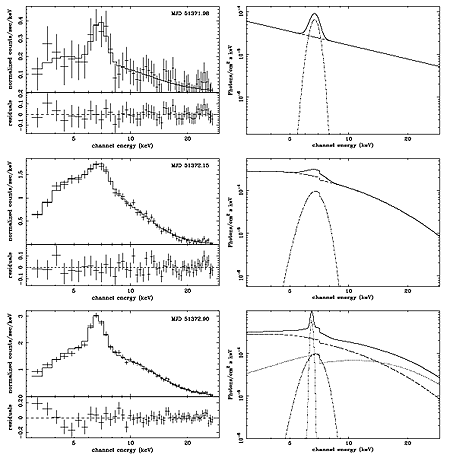Reflection of X-rays off companion stars and accretion disks
Reflection of X-rays off companion stars and accretion disks
When X-rays are reflected off of surfaces such as the atmospheres of stars and accretion disks we call the effect "Compton reflection". The effect is common to a large number of X-ray sources, most-notably active galactic nuclei and galactic black holes. Although models of reflection are used widely as a diagnostic of accreting sources, they remain poorly calibrated against well-understood atmospheric environments. There are question marks over the location and extent of the central X-ray source, and the incidence angles of the X-rays that illuminate the reflecting atmosphere. Since both direct and reflected photons are observed together, the reflecting source is typically a few percent of the overall flux. Consequently, contamination from the brighter spectral component handicaps our attempts to characterize and quantify reflection.The detection of an almost uncontaminated reflection spectrum is a rare event, but important in order to test and calibrate our understanding of X-ray reflection. One such source is the the companion star of the eclipsing X-ray pulsar Her~X-1 which is only visible in X-rays when the pulsar is obscured from our line-of-sight by a warped accretion disk. This environment is well-understood, we know the companion star's mass, size, shape, intrinsic temperature, composition and distance from the X-ray source. Atmospheric parameters such as density and pressure are well-constrained from main-sequence tables. The size, extent, spectrum and intensity of the pulsed X-ray source are also known. The characteristic light curve of X-rays reflected off the hemisphere of the companion star facing the pulsar is presented in the figure. Maximum light occurs when the companion star is directly behind the pulsar.

Also below are spectral fits to three of the visits to Her X-1. The top left panel is a powerlaw + Gaussian profile fit to mid-eclipse data (MJD 51371.98). The right hand panel presents the best fit model. The middle two panels are the corresponding fit and model for the post-eclipse visit at MJD 51372.15. At this time we cannot see the reflecting surface, which is over the limb of the companion star. The observed flux is light from the pulsar (a powerlaw continuum plus broad iron emission line), scattered off a corona over the accretion disk. The lower panels represent the visit at maximum flux, MJD 51372.90. Here we combine the coronal spectrum with a reflection spectrum comprising hard continuum component and a narrow iron fluorescence line at 6.4 keV.

